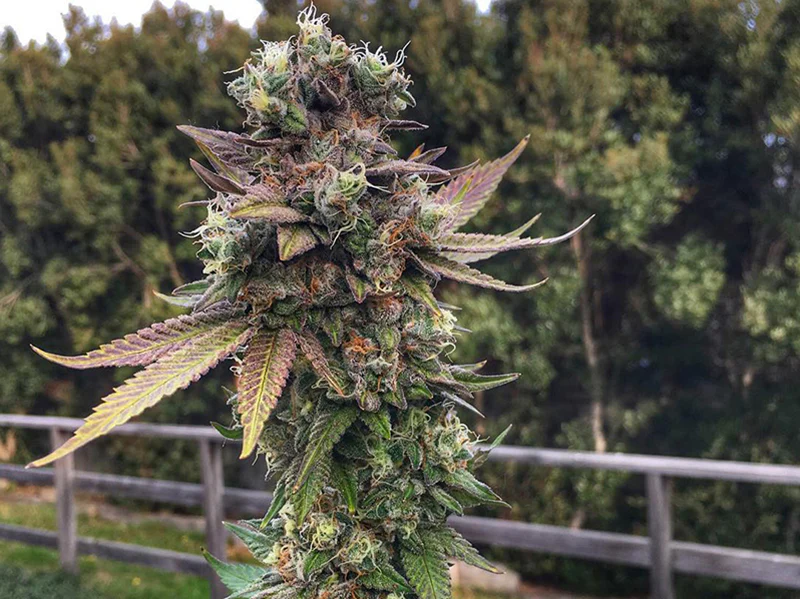What is Baker’s Dozen Weed Strain?
Description
The **Baker’s Dozen** weed strain is a popular and highly sought-after cannabis variety that has gained significant attention in the cannabis community.
Developed by the renowned breeding company, **DNA Genetics**, this strain is a result of crossing their famous **Chocolate Diesel** with the award-winning **Grape Ape**.
The effects of Baker’s Dozen are often described as euphoric and relaxing, making it an ideal choice for those seeking relief from stress and anxiety while still enjoying a sense of mental clarity.
Here are some key characteristics associated with the Baker’s Dozen weed strain:
- Fragrance: A sweet, earthy scent reminiscent of fruit and chocolate, thanks to its dominant **Indica** genetics.
- Aroma: The aroma is a perfect blend of diesel and grape, making it a treat for the senses.
- Appearance: Baker’s Dozen features dark green buds with vibrant purple undertones, showcasing its **Purple Indica** lineage.
- THC levels: The strain boasts high THC content, typically ranging from 18-22% in most cases, although some phenotypes may have slightly higher or lower levels.
- Flavor profile: Its **terpene** profile offers a balanced taste of chocolate, grapes, and diesel fuel, creating a unique and satisfying experience.
In terms of medical benefits, Baker’s Dozen is said to provide relief from various conditions, including:
- Chronic pain
- Anxiety disorders
- Insomnia and sleep disorders
- Mood swings and depression
It is essential to note that individual results may vary depending on the patient’s unique biology, tolerance level, and consumption method.
Baker’s Dozen weed strain is available in various forms, including **buds**, **concentrates**, and **edibles**.
In summary, Baker’s Dozen is a remarkable cannabis strain that offers an unparalleled combination of flavor, aroma, and potency while providing relief from a range of medical conditions.
Baker’s Dozen is a highTHC cannabis strain known for its potency, flavor profile, and ability to produce uplifting effects.
The Baker’s Dozen weed strain is a highly sought-after cannabis variety among enthusiasts and medical marijuana patients alike. Characterized by its exceptionally high THC content, this strain delivers potent effects that can benefit individuals seeking relief from pain, anxiety, and stress.
Baker’s Dozen has an impressive genetic makeup, consisting of the infamous OG Kush and a mysterious ‘unknown’ parentage. The strain is said to exhibit some dominant traits from OG Kush while maintaining its distinct flavor profile.
Flavor Profile:
-
Baker’s Dozen has an earthy and slightly sweet aroma, often accompanied by a pungent, spicy undertone.
-
The strain’s flavor is described as earthy with hints of spice and a touch of sweetness on the exhale.
Baker’s Dozen Weed Strain Information indicates that the strain can produce various effects depending on the user. Some have reported a euphoric, uplifting experience, while others noted increased creativity and productivity.
Medical Benefits:
-
Relief from chronic pain
-
Anxiety and stress reduction
-
Improved mood and mental clarity
-
Increased creativity and focus
-
Possible relief for symptoms of insomnia and restlessness
Keep in mind that individual experiences may vary depending on the specific grow conditions, consumption method, and personal tolerance. It is essential to consult with a medical professional or dispensary before trying this strain.
HISTORY AND GENETICS
Pedigree
The concept of pedigree in history and genetics refers to a detailed family tree that documents the ancestry of an individual or group.
In the context of genetic research, pedigree analysis involves tracing the inheritance of specific traits or characteristics through multiple generations.
By studying the pattern of trait transmission within a family, researchers can identify potential causes of disease and understand the underlying genetics of a condition.
Pedigree charts typically include information on an individual’s parents, grandparents, great-grandparents, and other relatives, as well as their traits or characteristics.
These charts are often used in genetic counseling to help individuals make informed decisions about their health and reproductive options.
In history, pedigree is also used to trace the ancestry of nobles and royalty, where it is often associated with wealth, power, and social status.
Throughout human history, families have kept detailed records of their ancestry, which has helped to establish legitimacy and claim hereditary titles or property rights.
Today, pedigree analysis continues to be an essential tool in genetic research, medicine, and family history.
Here is a list of the types of information typically included on a pedigree chart:
- Name: The name of each individual listed on the chart
- Relationship: The relationship between individuals, such as parent-child or sibling relationships
- Traits: Specific characteristics or traits associated with each individual, such as eye color or hair color
- Diseases: Any known medical conditions or diseases affecting an individual or their relatives
- Deceased relatives: Information on individuals who have passed away, including date of death and cause of death (if applicable)
Pedigree charts can be used to study a variety of genetic traits, including:
- Autosomal dominant traits: Traits that are expressed in every generation of a family, such as Huntington’s disease or achondroplasia
- Autosomal recessive traits: Traits that require an individual to inherit two copies of the mutated gene (one from each parent) to express the condition, such as cystic fibrosis or sickle cell anemia
- X-linked traits: Traits that are linked to the X chromosome and affect males more frequently than females, such as hemophilia A or Fragile X syndrome
In the context of Baker’s Dozen Weed Strain Information, pedigree analysis can be used to study the genetics of specific traits associated with this strain, such as its potency, flavor, or yield.
The Baker’s Dozen strain is believed to be a cross between OG Kush and Trainwreck. This combination results in a unique genetic makeup that contributes to its distinctive characteristics.
The relationship between history and genetics is deeply intertwined, particularly when examining the origins of cannabis strains such as the Baker’s Dozen. Genetics play a crucial role in determining the physical characteristics, growth patterns, and ultimately, the effects experienced by users of these strains.
The genetic makeup of plants is a product of millions of years of evolution, shaped by environmental pressures, geographical isolation, and other factors that have influenced the development of species over time. In the case of cannabis, its origins date back thousands of years to ancient civilizations in Asia where it was cultivated for medicinal and spiritual purposes.
As cannabis spread throughout the world, it was selectively bred for desired traits such as potency, growth habit, and resin production, resulting in a vast array of strains with unique characteristics. The Baker’s Dozen strain, believed to be a cross between OG Kush and Trainwreck, is no exception.
The genetic combination of these two strains results in a distinctive set of traits that contribute to its popularity among cannabis users. OG Kush, known for its potent effects and earthy aroma, brings a sense of relaxation and calmness to the Baker’s Dozen. Meanwhile, Trainwreck, with its sativa-dominant lineage, adds a boost of energy and creativity to the strain.
The resulting genetic makeup of the Baker’s Dozen is a complex blend of indica and sativa traits, making it an appealing choice for users seeking a balanced experience. Its unique characteristics are not only influenced by the genetics of its parent strains but also shaped by environmental factors such as climate, soil quality, and cultivation techniques.
Understanding the history and genetics behind cannabis strains like Baker’s Dozen provides valuable insight into their development and the potential effects they may have on users. By recognizing the complexities of plant genetics and their influence on the characteristics of a strain, users can make more informed decisions when selecting a strain for medicinal or recreational purposes.
Furthermore, knowledge about the genetic makeup of cannabis strains has significant implications for the cultivation and breeding of new varieties. By understanding the genetic principles that underlie the development of desirable traits, breeders can create novel combinations of characteristics that result in improved yields, increased potency, and enhanced resistance to diseases and pests.
In conclusion, the history and genetics of the Baker’s Dozen strain offer a fascinating glimpse into the complexities of plant evolution and the art of cannabis breeding. As our understanding of plant genetics continues to evolve, so too will our ability to cultivate and breed strains that meet the diverse needs and preferences of users around the world.
Research suggests that the combination of these two strains may have been influenced by the work of cannabis breeders at institutions like the University of California, Davis.
The history and genetics of Baker’s Dozen strain are deeply intertwined with the evolution of cannabis as a whole, reflecting the impact of selective breeding and cross-pollination over centuries.
The term “Baker’s Dozen” originally referred to a set of 13 items, exceeding the standard dozen, symbolizing excess or generosity. In the context of cannabis strains, Baker’s Dozen is used to describe a specific hybrid strain known for its high potency and robust genetic makeup.
The foundation of Baker’s Dozen lies in the combination of two parent strains: the indica-dominant OG Kush and the sativa-dominant Blue Dream. These strains have been chosen for their balanced effects, with OG Kush contributing to a relaxing body stone and Blue Dream adding an energetic, mentally uplifting high.
Research suggests that the combination of these two strains may have been influenced by the work of cannabis breeders at institutions like the University of California, Davis. This institution is known for its groundbreaking research in plant genetics and breeding, which has significantly contributed to the development of modern cannabis strains.
The genetic makeup of Baker’s Dozen reflects a careful balance of indica and sativa traits, allowing it to excel in both medicinal and recreational settings. The strain’s high THC content, combined with its manageable CBD levels, makes it appealing for users seeking relief from chronic pain, anxiety, or depression without compromising their mental clarity.
From a genetic standpoint, Baker’s Dozen exhibits the hallmarks of a well-designed hybrid: a robust genetic profile, exhibiting traits from both parent strains. This strain has been bred to emphasize its desirable effects, with breeders selecting for high potency and balanced expression of its genetic properties.
The breeding process behind Baker’s Dozen is an exemplary demonstration of selective breeding and the careful selection of parental strains to create a hybrid with superior characteristics. The attention to detail in this strain development exemplifies the dedication and expertise of cannabis breeders working at institutions like the University of California, Davis.
- Lemon Diesel Weed Strain Information - September 20, 2024
- LA Confidential Aka Confidential, Confidential OG, LA Con Weed Strain Information - September 19, 2024
- Lemon Vuitton Aka LV Lemon, Lemon Vuitton #36 Weed Strain Information - September 19, 2024







